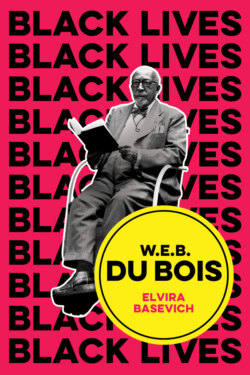W.E.B. Du Bois

Реклама. ООО «ЛитРес», ИНН: 7719571260.
Оглавление
Elvira Basevich. W.E.B. Du Bois
CONTENTS
Guide
Pages
W. E. B. Du Bois. The Lost and the Found
Acknowledgments
Introduction Du Bois Among Us: A Contemporary, A Voice from the Past
Notes
1 Du Bois and the Black Lives Matter Movement: Thinking with Du Bois about Anti-Racist Struggle Today
The black lives lost
Trust: do you see what I see?
Lifting the veil: de-colonizing the white moral imagination
Mourning and moral faith
Notes
2 Student Days, 1885–1895: Between Nashville, Cambridge, and Berlin
Du Bois’s childhood, formative experiences, and student days
Du Bois’s early political thought
The normative basis of anti-racist political critique
The is/ought distinction
A Kantian normative scheme in Du Bois’s political thought
Legal versus civic equality
Ideal versus nonideal theory
A different kind of ideal theory? Du Bois’s ideal of civic enfranchisement and the inclusion/ domination paradigm
Notes
3 The Emergence of a Black Public Intellectual: Du Bois’s Philosophy of Social Science and Race (1894–1910)
The unhesitating sociologist (1894–1911)
Du Bois’s philosophy of social sciences
Du Bois’s philosophy of race: reconsidering racialism
Political and cultural theories of race
Revisiting Hegel’s concept of spirit
Interracial civic fellowship and the cosmopolitan condition
Notes
4 Courting Controversy: Du Bois on Political Rule and Educated “Elites”
Washington–Du Bois debate
The role of the “talented tenth”
The politics of leadership and desegregation in Long Island, New York
Notes
5 A Broken Promise: On Hegel, Second Slavery, and the Ideal of Civic Enfranchisement (1910–1934)
Du Bois in Harlem
Second slavery and democratic theory. A legitimation crisis in the postbellum United States
Du Bois’s philosophy of the modern American state
American Sittlichkeit, or the modern state in concreto
Public reason in the circle of citizenship: on the self-conscious development of institutional rationality
Radical Reconstruction (1865–77): on the self-conscious development of institutional rationality in the postbellum United States
On the family
On emancipated black labor
Why Du Bois is neither an elitist nor an assimilationist
The contemporary implications of a “second slavery”
Mass incarceration and prison labor
On Walmart and Amazon: the two largest employers in the private sector
Building an interracial labor movement
Notes
6 Du Bois on Sex, Gender, and Public Childcare
The Du Bois household
Du Bois and the women’s suffrage movement
Right to motherhood outside the nuclear family
The black church and women as civic leaders behind the color line
Childcare: actualizing the value of the civic equality of black women
Notes
7 Du Bois on Self-Segregation and Self-Respect: A Liberalism Undone? (1934–1951)
Du Bois’s black nationalism and Marxism: economic grounds for voluntary self-segregation
What’s left of the liberal ideal of civic enfranchisement?
Du Bois’s dissatisfaction with the Communist Party
A closer look at double consciousness as an effect of the color line
An orthodox liberal approach: Kant on self-respect
Double consciousness reconsidered: Du Bois’s defense of black self-segregation as black self-respect
Du Bois’s reservation about the desegregation of schools
Contemporary implications: the politics of self-segregation today
Notes
Conclusion. The Passage into Exile: The Return Home Away from Home (1951–1963)
Du Bois’s life, scholarship, and activism in his last decade (1951–1963)
Between domestic justice and cosmopolitanism: the pan-African movement in the black diaspora
After exile: Du Bois’s legacy today
Notes
Index. A
B
C
D
E
F
G
H
I
J
K
L
M
N
O
P
R
S
T
U
V
W
Y
Z
POLITY END USER LICENSE AGREEMENT
Отрывок из книги
Black Lives series
Elvira Basevich, W. E. B. Du Bois
.....
Mutual trust is necessary to sustain the bounds of civic fellowship and a shared sense of political fate. Trust often mediates what one takes to be true and is ready to accept as a feature of a shared reality that binds a stranger’s destiny to one’s own. In granting credibility to an interlocutor, one takes their experiences of the world to be a true representation of the world. Yet in an age of the rapid dissemination of information through the internet and social media, the refusal to trust black voices persists. Distrust and suspicion are the cause of racial violence – a fact exemplified in the killing of Eric Garner. The moments leading up to Garner’s death were caught on cellphone video and watched by millions. A Staten Island resident, Garner was killed in 2014 in an illegal chokehold by ex-officer Daniel Pantaleo.11 Yet there remains little consensus about what the footage means. Prior to his death, Garner repeated eleven times “I can’t breathe,” a phrase that is now a rally cry of the BLM movement. Pantaleo did not believe Garner that he really couldn’t breathe; or else, he simply didn’t care. Likewise, many members of the public still do not believe that Garner’s death was avoidable, or else they simply don’t care one way or another. In effect, they just don’t trust that he really couldn’t breathe.
In an interview, Garner’s youngest daughter, Emerald Garner, responded to the news that four years after Pantaleo had killed her father he was finally fired: “We’re grateful that someone sees what we see.”12 In contrast, the NYC police union leader, Patrick Lynch, denounced Pantaleo’s firing. Lynch asserted that the firing encourages assaults on police officers. Of course, police officers’ distorted perception of their own vulnerability to attack by African Americans rationalizes their use of deadly force in the first place. Moreover, officers often fabricate police reports to suggest a victim posed a threat, knowing that they enjoy the public’s trust that their black and brown victims lack. The public’s inclination to trust police officers and distrust their victims persists, in spite of video footage of fatal police encounters. In response to Lynch, Emerald Garner said:
.....